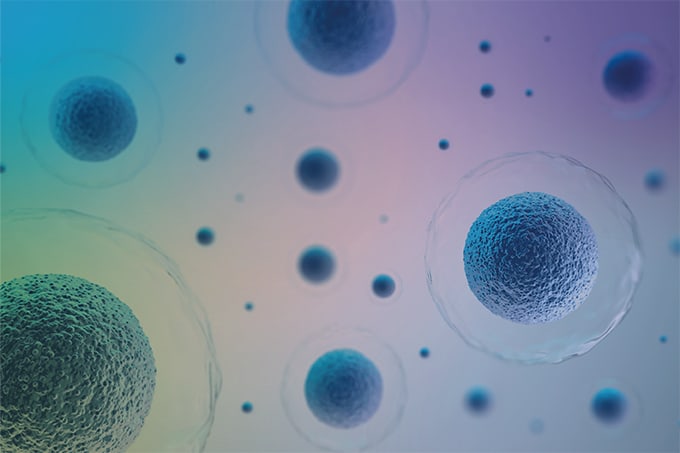
“The single-cell analysis field has really blossomed over the past decade” is a phrase you’ll often hear. And given the sheer number of talks and posters focused on single-cell analysis you’ll see at conferences like ASMS these days, it’s hard to argue. In fact, the field has come so far over the past few years that many seem to think that “single-cell analysis” didn’t really exist until researchers began using mass spectrometry to study omics at the level of single cells. But measuring single cells – with microscopy, originally – dates back to Robert Hooke, nearly 400 years ago. Indeed, “single-cell analysis” is how we learned about cells having nuclei and other fundamental features. Microscopists first named brain cell types hundreds of years ago based on their shapes – stellate (star-shaped) cells, pyramidal cells, and so on – because that’s what they could measure.
Of course, what we can measure has changed dramatically, which has opened the door to single-cell chemical analysis – which we can differentiate from temporal or spatial analysis. Single-cell mass spectrometry began in the 1970s, with Hillenkamp and others using lasers to ionize compounds in cells. Around the same time, there were a few reports of single-cell analysis using gas chromatography-mass spectrometry (GC-MS). But the real acceleration came in the 1990s, due to instrumental improvements. Back then, if you isolated a cell with few losses and carefully optimized every step, you might detect a few compounds in a single cell. Owing to significant advancements in sensitivity, today we can routinely detect dozens, even 100 compounds, without the need for complete procedural optimization.
These sensitivity improvements have made single-cell chemical analysis more robust and accessible. This is why the field has grown so much – it’s easier to achieve meaningful results with the tools we now have without the need for heroic efforts.
Nevertheless, what interests me most is what we can’t yet measure – the opportunities for discovery and the hurdles to overcome – which is what I’d like to explore here.
“The incredible heterogeneity of cells”
Right now, scientists are pretty good at transcriptomics, and single cell proteomics is also advancing rapidly. However, there are still invisible parts of the cellular landscape, and this is what fascinates me.
Take metabolomics: if you look at a metabolomic profile of a brain region, you might detect 1,000 or more metabolites. But at the single-cell level, you’re often limited to detecting 50 lipids or 50 metabolites. It’s not very deep coverage, but even with this limited depth, you can observe striking differences between cells. It’s ironic that metabolites were the first molecules measured in cells, but now metabolomics has become the most challenging and slowest field to develop!
In the brain, for example, some cells use serotonin, whereas others might use dopamine, glutamate, or GABA instead. For many compounds, the cell-to-cell differences are much larger than people realize. Biochemistry textbooks might suggest uniform concentrations of molecules such as citrulline or arginine succinate, but in reality these molecules are only present in a small fraction of cells. In some cases, we measure near-millimolar levels in a few cells and almost nothing in others, thus yielding the expected millimolar average levels. This example highlights the incredible heterogeneity of cells.
Another factor that’s often overlooked is the sample itself. Many researchers working on single-cell measurements use cell cultures, and although these can teach us a lot they tend to be homogeneous, as the cells are grown under very similar conditions. If you examine freshly isolated cells from a brain, you begin to see much more striking differences.
As another example, in our work with islets, cell to cell differences define cell types; beta cells contain insulin, alpha cells have glucagon, and gamma cells hold pancreatic polypeptide. Occasionally, we find cells with unexpected peptides, like oxyntomodulin instead of glucagon in alpha cells. These differences are massive – 100-to-1 or more in the level changes between cells. People sometimes ask about statistics, but in these types of cases there’s no need for subtle statistical tests; the differences are so stark that they’re unmissable.
This is also true for neuropeptides in the brain and other endocrine systems. The need to observe these differences helps drive the development of new single cell measurement technologies. Additionally, observing these huge variations in cellular signaling molecules highlights the importance of pushing the boundaries of single-cell analysis.
An omic dichotomy
One of the more interesting dynamics, particularly for an analytical chemist, is the contrast between transcriptomics and proteomics. With proteomics, if you’re measuring a protein with mass spectrometry, analytical journals may not accept your results unless you fully characterize the protein, including post-translational modifications (PTMs). If you identify a protein but don’t report its phosphorylation states, amidation, or acetylation, you’ll be told that you didn’t do a thorough enough job.
On the other hand, transcriptomics gives you sequences, and although methylation studies have been developed, transcriptomics alone does not fully characterize most RNA PTMs. It only tells part of the story, but the field is considered highly successful nevertheless. That dichotomy is intriguing – proteomics demands near-perfection, while transcriptomics has achieved widespread success without the requirement of complete molecular characterization.
Looking ahead 20 years, I wouldn’t be surprised if a majority of people are using nanopores to sequence proteins. While this is exciting, nanopores may not capture all PTMs. For example, glycosylated proteins might not fit through the nanopore holes, and yet, nanopore sequencing could still be incredibly useful – just like transcriptomics has been. In this scenario, mass spectrometry would complement nanopore sequencing by filling in the gaps and providing the rest of the molecular details.
Will mass spectrometry continue to improve? Absolutely – it’ll get faster, better, cheaper, and more accessible. But in many cases, the way we approach proteomics might look very different. Meanwhile transcriptomics is starting to tackle PTMs, and I expect both areas to see incremental advancements as well as revolutionary changes.
Sample preparation (and the unavoidable issue)
When handling an organism – whether it’s a mouse or something else – you’re dealing with a living system.
It doesn’t matter whether you’re using matrix-assisted laser desorption ionization (MALDI) imaging, electrospray, or even ambient techniques like desorption electrospray ionization (DESI), you still have to somehow get the molecules out of the brain and into the mass spectrometer. This process is inherently destructive – you might drill a hole in a skull and insert a probe. Alternatively, you can dissect the brain or work with living ex vivo brain slices, which we sometimes use, but even then, it’s a highly disruptive process.
The core issue is: how do you sample without perturbing the system? Unfortunately, the answer is probably that you can’t, at least not completely. This isn’t just a challenge for mass spectrometry; it’s also an issue for fluorescence imaging and similar techniques. When dealing with small molecules, especially short-lived ones like endogenous nitric oxide, it’s nearly impossible to capture them in their natural state without altering the system.
Moving to a different topic; as a journal editor, I’ve noticed the difficulty in establishing standards for reporting data. People are comfortable with universal standards, but the single cell field is advancing so quickly that it’s hard to create one-size-fits-all guidelines. Take mass spectrometry: MALDI imaging is very different from LC-MS, and the standards for one don’t necessarily apply to the other. Some journals have created reporting standards for LC-MS, but if those were strictly applied to mass spec imaging, much of that data wouldn’t meet the criteria for publication. Similarly, new technologies like nanopore sequencing generate different types of information entirely and likely will require distinct reporting standards.
As the field evolves, whether it’s in sampling methods, measurement approaches, or data analysis, it's difficult to establish fixed community standards. While standards are important for existing techniques, we also need to recognize that this rapid pace of innovation requires flexibility. Unlike X-ray crystallography, where methods and standards have remained relatively stable, technologies in single-cell analysis and mass spectrometry are constantly changing.
Unnecessary granularity?
If the goal is broad-scale chemical measurements, omics will remain important for the single-cell analysis field, particularly for comprehensive data instead of targeted approaches. Just as transcriptomics evolved from analyzing regions to single cells, I predict similar progress to happen with other omics fields.
That said, there’s a certain "cachet" associated with single-cell analysis right now which I sometimes see people wanting to apply unnecessarily. If you don’t need that level of detail, you simply don’t need to do it – it’s harder, generates significantly more data, and requires more effort to interpret.
For example, single-cell analysis can be crucial if you’re studying the brain to understand how astrocytes, oligodendrocytes, microglia, and neurons interact, or how neurons change during learning, memory or disease. Similarly, single-cell approaches in cancer research are often essential to understand cellular heterogeneity. But in cases where you don’t need that granularity, it’s better to stick with the bulk measurement approaches.
The important question is: does single-cell analysis provide the data required to answer your scientific question? If the answer is yes, then it’s worth pursuing, despite the added complexity.
Whether you’re analyzing single cells or a microliter sample containing 100,000 cells, the goal is still to obtain the most complete information possible – typically on an omics scale. Transcriptomics, for example, is often easier to perform and may remain so. One reason for this is that transcripts and proteins are somewhat correlated, while the relationship between small molecules (metabolomics) and the transcriptome is far looser. A cell’s metabolome is highly dynamic, influenced not just by its internal state but also by the environment.
In some cases, you’ll find a good correlation between the metabolome, proteome, and transcriptome. In many others, the correlation is weak, and the only way to know is to measure it. While transcriptomics often reflects the cell’s state, the metabolome represents its dynamic response to the outside world. This interplay makes metabolomics both crucial and challenging to interpret.
Even though metabolomics might offer more insights in certain cases, many labs prioritize transcriptomics because it is easier to perform and provides a starting point for understanding the system. From there, one can gradually integrate metabolic data to paint a fuller picture.
Coming together
Moving forward, there’s no question that the chemical analysis of individual cells will grow in importance.
One exciting avenue for the field is the potential integration of chemical and spatial data at the single-cell level. Combining morphology and imaging to achieve nanoscale spatial resolution in optics while incorporating chemical omics information would be transformative for the field. I predict that this will be a major growth area.
Ultimately, although the field may have blossomed in recent years, we're only beginning to address fundamental questions – many of which we don’t yet fully understand. To give one final example, in the brain: what’s the difference between cell state and cell type? If you take an astrocyte from two different locations with distinct chemical environments, are they fundamentally the same cell type, even with distinct transcripts and metabolites? One astrocyte may be in a location where it manages extracellular dopamine, while the other deals with extracellular GABA. Do such environmental differences eventually change the cells into distinct cell types or are the differences reversible and reflect cell state?
Perhaps the full blossoming has yet to come.




